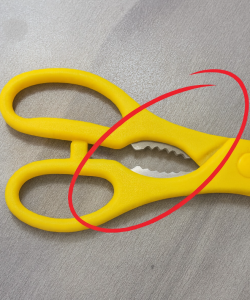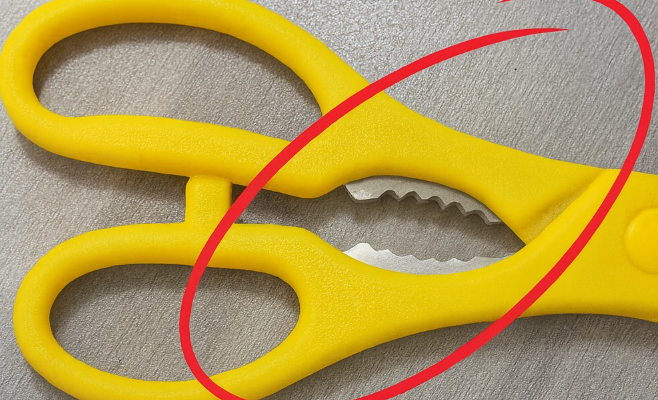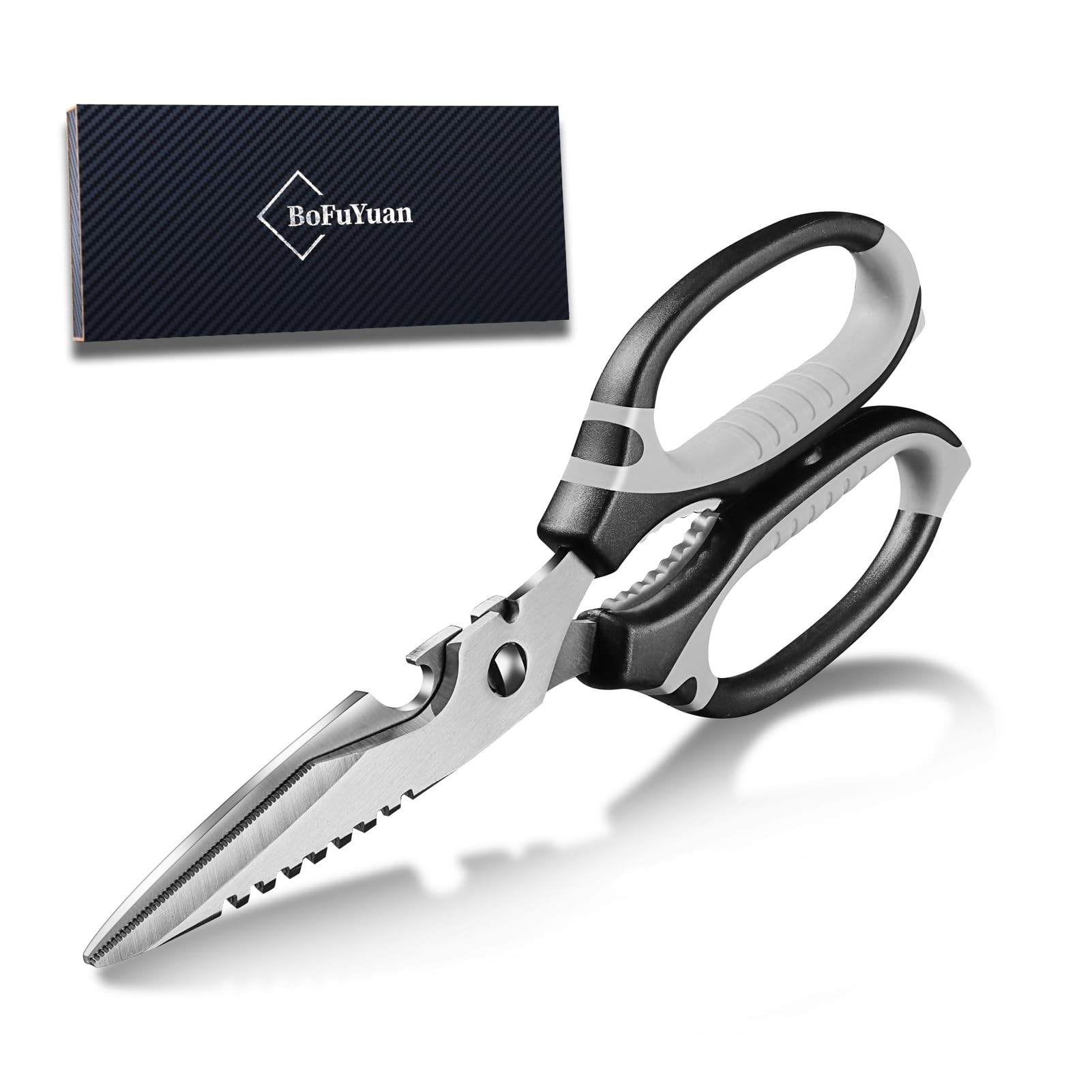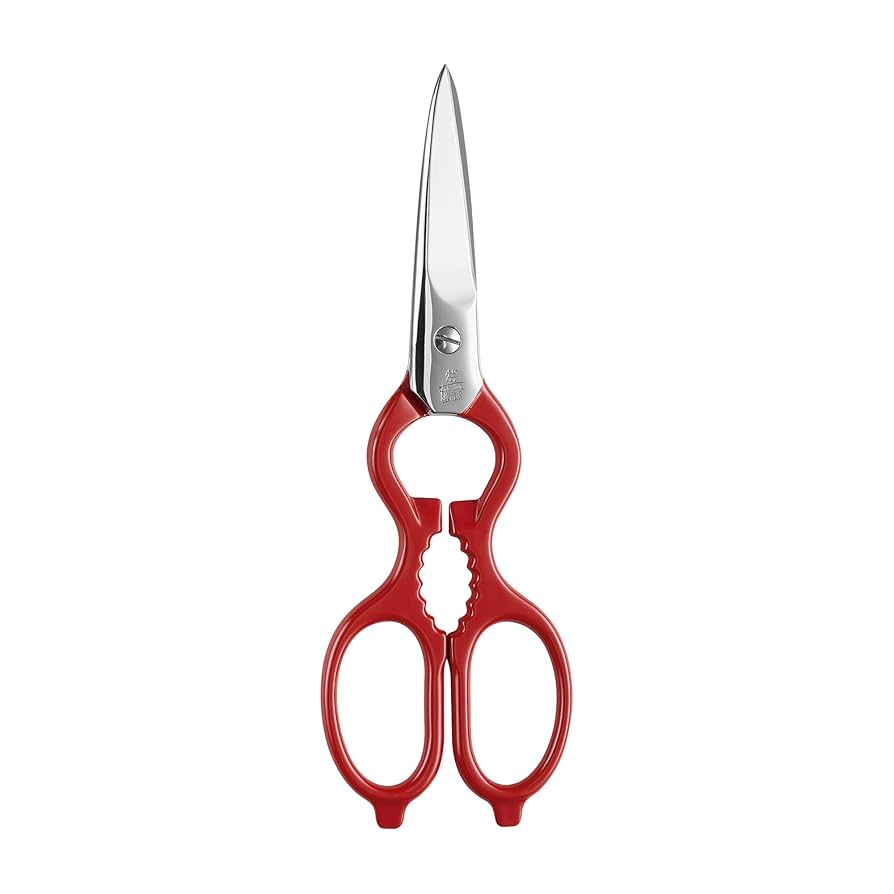
If you’ve ever used a sturdy pair of kitchen scissors, you’ve probably noticed something curious hiding between the handles: a jagged, toothed section that doesn’t look much like the cutting blades. It almost resembles a tiny set of jaws or the teeth of a bottle cap opener. Many people never give it a second thought, or worse — assume it’s just decorative. But that little toothed part is actually one of the most practical and clever features of kitchen shears.
Let’s break down exactly what that toothed section does, why it exists, and how it can make your life in the kitchen a whole lot easier.
1. It’s Not Just Scissors — It’s a Built-In Grip Tool
The main purpose of the toothed part on kitchen scissors is to act like a grip or clamp. Unlike the smooth plastic handles, those small teeth can bite into objects that are otherwise hard to hold — like slippery jar lids, bottle caps, or even chicken bones.
When you press the handles of the scissors together with something wedged between the teeth, the serrations provide extra friction. This allows you to hold or twist items without them slipping. Think of it as a mini pair of pliers or a jar opener built right into your scissors.
This feature is especially handy when your hands are wet or oily from cooking. Instead of struggling with a stuck cap, you can let the tool do the gripping for you.
2. Opening Stubborn Bottle Caps and Jar Lids
One of the most common uses for the toothed section is to open twist-off bottle caps or small jar lids.
Here’s how it works:
-
Position the bottle cap between the teeth.
-
Squeeze the handles together gently but firmly.
-
Twist the scissors like you would with your hand.
Because the toothed edges dig into the metal or plastic cap, you get a much better grip than with just your fingers. This can be a lifesaver if you have reduced hand strength or the cap is especially tight.
For larger jars, it won’t open the lid entirely, but it can help break the seal, making it easier to finish twisting by hand.
3. Crushing and Cracking Hard Foods
That little toothed notch is surprisingly strong. Many kitchen shears are made of tough stainless steel, and the grip area can be used to crack hard shells.
Common examples:
-
Nuts: Like walnuts or pecans.
-
Shellfish: Cracking lobster claws, crab legs, or shrimp shells.
-
Bones: Snapping small chicken bones or breaking through cartilage.
This can be much safer than trying to use the blade for the same purpose. Instead of putting pressure on the sharp cutting edges, which could cause the blade to slip or dull, you let the teeth do the gripping and crushing.
Just be sure to apply steady pressure and not twist too aggressively on delicate shells, or they might shatter.
4. Opening Stubborn Plastic Packaging
We’ve all struggled with thick plastic packaging — the kind that seals scissors, electronics, or kitchen gadgets inside a nearly indestructible plastic shell. That toothed part can help grip the hard edge of the packaging, making it easier to pull apart after you’ve made an initial cut.
Some people even use it as a kind of “starter grip,” holding one edge of the plastic while they cut with the blades. This reduces the risk of slipping and accidentally cutting yourself.
5. Twisting and Pulling
Because of their ergonomic design, kitchen shears give your hand more leverage than just your fingers. The toothed area is often placed in the exact spot where your grip is strongest. This means you can twist caps, open seals, or pull apart tough materials with minimal effort.
Some practical uses include:
-
Twisting open soda bottle caps or drink caps that are tightly sealed.
-
Pulling the metal seals off bottles like olive oil or soy sauce.
-
Gripping and twisting open stubborn condiment containers.
Think of it as a universal helper for anything round, hard, or slippery.
6. Safety Advantage
One of the biggest advantages of using this built-in grip feature instead of your hands is safety. When people struggle to open something with wet or greasy fingers, they often end up applying more force than they should — and when the lid finally gives, it can cause spills, broken glass, or even hand injuries.
With the toothed section, your grip is secure. The risk of the item slipping suddenly is reduced, and you can use controlled pressure to open it. This is especially useful for children, elderly people, or anyone with reduced hand strength.
7. A Hidden Multi-Tool in the Kitchen
Modern kitchen shears aren’t just for snipping herbs or cutting chicken. They’re designed as multi-tools for cooking, prepping, and opening. The toothed grip is part of this evolution.
Many models combine several functions in one tool:
-
Cutting blades for herbs, vegetables, meat, and packaging.
-
Serrated inner teeth for gripping lids and cracking shells.
-
Bottle opener built into the handles.
-
Nutcracker function between the teeth.
-
Jar seal breaker with leverage design.
This makes kitchen shears a surprisingly powerful gadget. In small kitchens, one good pair can replace several single-purpose tools.
8. Why the Teeth Work So Well
The secret to their effectiveness lies in basic physics. The serrations increase friction between the tool and the object, meaning less force is needed to hold on tightly. The V-shaped indentation of the teeth also centers round objects like bottle caps, keeping them from slipping out of your grip.
Additionally, the lever design of the scissors means your hand force is amplified through the tool. That’s why you can twist a cap with the scissors more easily than with bare fingers.
9. How to Use the Toothed Part Properly
To get the best results and avoid damaging your scissors or hurting yourself, here are a few simple tips:
-
Grip, don’t crush: You don’t need to squeeze too hard; let the teeth do the work.
-
Keep it clean: Food residue can reduce grip. Wash and dry the toothed section after each use.
-
Match the size: It’s meant for caps, lids, and objects that fit snugly. Oversized items may damage the tool.
-
Use it as intended: Don’t use it as a wrench or to twist very thick metal caps.
10. Beyond the Kitchen
Interestingly, the toothed section isn’t only useful for cooking. Many people use their kitchen scissors for household tasks like:
-
Opening paint can lids (small ones).
-
Loosening tight bottle tops in the garage or workshop.
-
Breaking plastic ties or seals.
-
Holding slippery wires or cords when tying or cutting.
While the tool was designed with the kitchen in mind, its usefulness extends to many areas of everyday life.
11. A Bit of History
The idea of adding a toothed grip between scissor handles became popular when kitchen shears evolved from basic cutting tools into all-in-one utility gadgets. Early versions appeared in the mid-20th century, when home cooking surged in popularity and manufacturers started looking for ways to make kitchen tools more versatile.
The toothed grip was a simple yet ingenious addition: it didn’t require extra moving parts, it didn’t make the scissors heavier, and it added multiple new functions at no extra cost.
Today, nearly every high-quality pair of kitchen shears includes this feature — proof that good design stands the test of time.
12. Small Feature, Big Impact
It’s easy to overlook small details on everyday tools, but sometimes those details are what make the tool truly useful. The toothed part of your kitchen scissors might seem insignificant, but it can save you from struggling with stuck lids, slippery packaging, or hard shells.
Instead of reaching for multiple gadgets, you can use one simple tool to handle several kitchen tasks. And because the toothed section is built right between the handles, it’s always there when you need it.
Final Thought
That strange, toothed part on your kitchen scissors isn’t strange at all — it’s smart design. It gives you leverage, grip, and versatility. It’s a nutcracker, a cap opener, a jar helper, and a gripping tool all in one.
Next time you find yourself wrestling with a stubborn bottle cap or shell, remember: the answer might be sitting quietly in your kitchen drawer, built into a pair of scissors you’ve been using for years without realizing its full potential.




